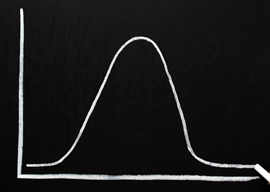
October 01, 2014

Source: Shutterstock
October 2014 marks the 20th anniversary of the publication of the most hated book in the history of the social sciences, the 845-page The Bell Curve: Intelligence and Class Structure in American Life by Charles Murray and the late Richard J. Herrnstein.
Back in 1994, innumerable pundits informed us that only low-IQ idiots like those haters Herrnstein and Murray were so repulsively stupid as to not know that smart people don”t believe in intelligence anymore. Or something. The critics weren”t wholly coherent, but their rage was clear. (As Freud noted, projection is a widespread tendency.)
One of the less vituperative denunciations by the many reviewers who likely hadn”t actually read the book was by “civil rights lawyer, Barack Obama.” The future president intoned on NPR in 1994:
The idea that inferior genes account for the problems of the poor in general, and blacks in particular, isn’t new, of course. Racial supremacists have been using IQ tests to support their theories since the turn of the century. … With one finger out to the political wind, Mr. Murray has apparently decided that white America is ready for a return to good old-fashioned racism so long as it’s artfully packaged and can admit for exceptions like Colin Powell.
Of course, the irony is that Obama’s fabulous career epitomizes the prime subject of The Bell Curve: the rise of a “cognitive elite” facilitated by standardized testing.
You may have the impression from all the excoriations that The Bell Curve is all about the gap between whites and blacks in average intelligence. As Murray noted in explaining his book’s surprising sales:
The descriptions of The Bell Curve as an angry, racist polemic have led people in bookstores to pick it up to see what the fuss is about. The pages to which they turn are nothing like what they expect, their curiosity is piqued, and some of them buy it.
In reality, the white-black gap is the subject of Chapter 13, “Ethnic Differences in Cognitive Ability.” Herrnstein and Murray conclude that chapter in their usual thoughtful, reasonable style:
If the reader is now convinced that either the genetic or environmental explanation has won out to the exclusion of the other, we have not done a sufficiently good job of presenting one side or the other. It seems highly likely to us that both genes and the environment have something to do with racial differences. What might the mix be? We are resolutely agnostic on that issue; as far as we can determine, the evidence does not yet justify an estimate.
The gap that The Bell Curve documented nearly a generation ago is still the subject of Establishment obsession. In 2002, Ted Kennedy and George W. Bush got together to solve the gap by passing the No Child Left Behind law, which legally mandated that by the spring of this year every public school student in America would be above average.
Not surprisingly, NCLB instead brought about massive test fraud. So now American elites have pinned their hopes on the Common Core, which will close the gap by making coreness common. Or something. Nobody seems to agree on how it’s supposed to work, but it has to work, right? Otherwise The Bell Curve will be right, and that’s just wrong.
In truth, The Bell Curve is essentially a book about the growth of inequality, the evolution of a self-perpetuating elite that can verbally bafflegab any rivals for power. Thus, the first four chapters of The Bell Curve are grouped together to depict the book’s central subject: “The Emergence of a Cognitive Elite.”
The inevitable impact of testing on society had been a theme of Herrnstein‘s (a prominent Harvard psychology professor who had been B.F. Skinner’s most expert disciple before growing bored with behaviorism) since his 1971 Atlantic article “I.Q.“
Herrnstein’s full essay is not online, but my vague recollection of it from when I read it at the library in 1972-73 is that he begins with a stylized example of a small rural village sometime in the past. There’s one extremely bright youth in this isolated locale, but since nobody ever marries outside of the village, he has to marry a woman of only moderately high intelligence. The practical difficulties of assortative mating mean that some degree of hereditary equality survived over the generations.
(I suspect, however, that New York City-born Herrnstein, the son of a Jewish house painter from Hungary who ran New York’s only Hungarian-language theater in his spare time, didn”t have all that much firsthand knowledge of American rural life. Economic historian Gregory Clark‘s research on social mobility implies that assortative mating was being enthusiastically practiced long before the SAT was invented.)
Herrnstein contrasted that with 1971 America, in which standardized tests are used to recruit bright boys and girls to national universities, where nature takes its course:
The data on I.Q. and social-class differences show that we have been living with an inherited stratification of our society for some time. The signs point to more rather than less of it in the future.
Because the smartest men and women now marry each other more than in the past and give their descendants advantages in both nature and nurture, how will inequality not increase?
Good question. Today, more than 40 years after I read Herrnstein’s pioneering article, the subject of inequality has become one of obsessive interest.
Both Herrnstein and Murray”the pride of Newton, Iowa“made it to Harvard in part because of standardized exams.